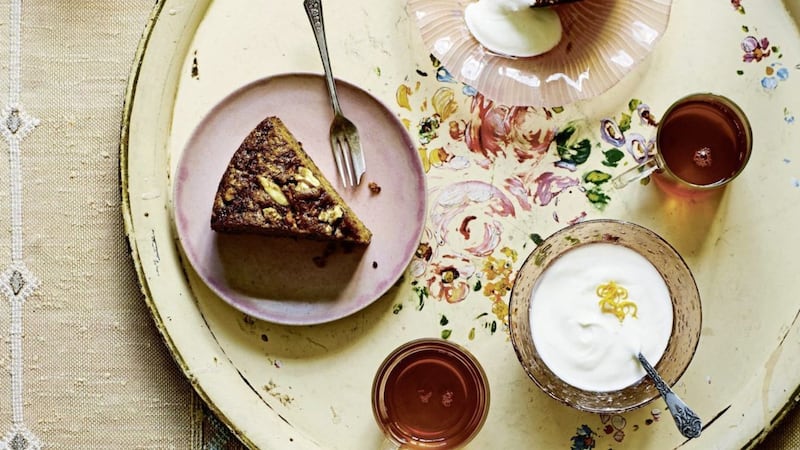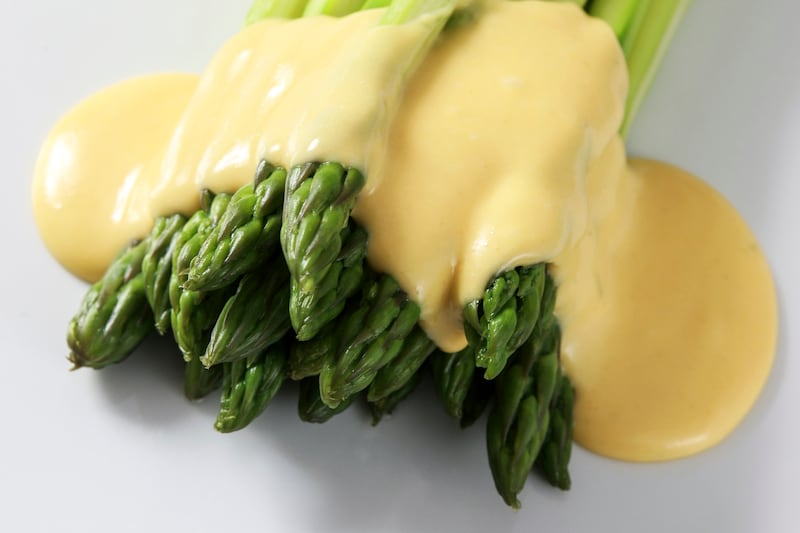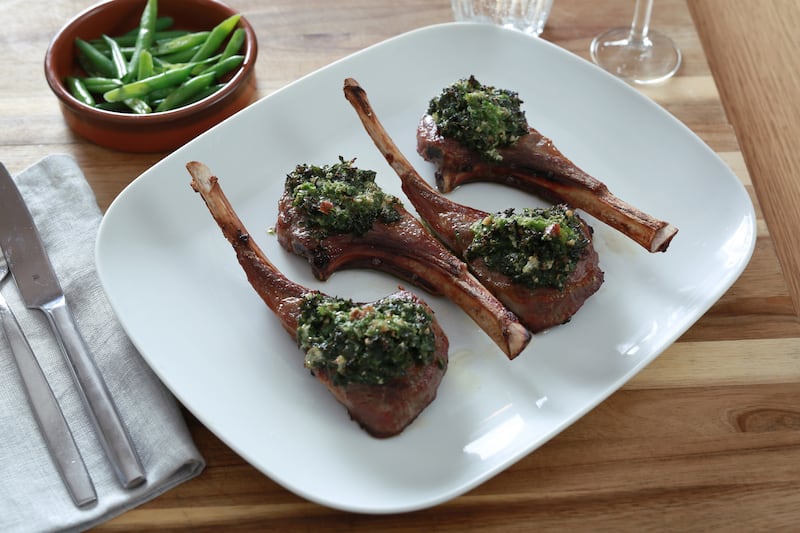WHEN food writer and cookbook author Alissa Timoshkina talks about snow – the glittering kind she misses, the kind that falls thickly in Siberia – the present fades out.
"Massive snow plains, and walking in fresh snow, is the most beautiful and breath-taking sight," she says. "The crunch, the sound of it is incredible, the texture under your feet – it's quite magical."
Back in north London where we've met to talk, there is only drizzle, but the table is laid with dishes from Timoshkina's debut cookbook, Salt & Time – beetroot fritters, soured cream courgette dip, vinegret salad and aubergine caviar – while her new baby daughter Rose snuffles away happily (she appears as the star bump in the book).
Two years ago, the Russian-born, Siberian-raised cook, realised there weren't any really good contemporary Russian cookbooks to be found. Anywhere.
"Anything you do find is really old and dated, and the aesthetics, it's just so kitsch," she says of the raggedy recipe collections you might unearth in charity shops. Her photographer on Salt & Time recently dug one out, the cover emblazoned with pictures of a Russian woman in a crown, a samovar and a bear. "Could this be any more cliched?" Timoshkina asks with a laugh. "It's just so boring."
And boring Russia is not – especially when it comes to culture, cuisine and politics.
"Obviously in the news, politically, you hear about Russia quite a lot – not in the best light," Timoshkina muses. "But still, everyone knows Russia and is fascinated by Russia, yet the food is such a huge part of any culture, and it's such a great way of learning about a culture. So I thought, 'What's going on?'"
Salt & Time: Recipes From A Russian Kitchen fills this gap. In it, Timoshkina features the food she creates at home (like those beetroot patties, which are genuinely incredible) and revisits the food of her childhood, the fare her mum and grannies cooked, and the traditional Russian dishes that are dinner staples for many who grew up in the former Soviet Union – although she does put quite a spin on them.
She's very clear, she's "not an anthropologist just recording authentic recipes" but instead adapts and updates, taking inspiration from elsewhere as she goes. Consider 'herring under a fur coat': the layered Russian salad is traditionally a psychedelic cake of pickled herring, mayonnaise, onion, and grated boiled veg – including the bright pink of beetroot. Timoshkina's version is elegant, minimalist; the traditional is straight out of the 70s.
Timoshkina grew up in Siberia and lived in Israel for a bit ("I'm happy I tried my first hummus in Israel"), before moving to England in 1999, aged 15.
In retrospect, she says the school food she was subjected to on arrival wasn't actually that bad, but at the time, fresh from a land of ferments, pickles, krauts and foraged foods, it was certainly "strange". "Hash for breakfast, fish and chips – there was so much fried stuff," she recalls, bemused.
She began cooking seriously as a way to escape the intense study of her PhD in Soviet Holocaust and Film History. Then, once she was done with academia, she threw herself into running monthly supper club and film event company, KinoVino.
"It was the best cooking school because I'd always help the chefs prep and be with them in the kitchen during the event," she explains.
The process gave her the confidence to cook herself, she says. However, the kitchen has always been a huge part of her world. As a child, it was the main communal space, particularly in small soviet apartments at a time when you didn't eat out except for pickles from the market, or patties from the store. It's where the grown-ups would be smoking, chatting "and drinking vodka", and her great-granny could be found making pastries and proving dough in huge enamel casseroles.
Her great-granny's celebratory Napoleon cake – a colossal mille-feuille of pastry and creme patisserie, a Soviet dessert invented in 1912 to celebrate the centenary of Russia's victory over French invasion – is in the book.
"She was known for making the best Napoleon cake in our family. It's quite a laborious thing to make," says Timoshkina. "It had a very special significance, and my great-granny was very special to me.
"When I was testing her recipe, I looked at others, and hers has an obscene amount of butter in it. At first I was like, 'Is that right?!' But it tastes so good, I immediately saw her kitchen [in my head]. It was just so moving; tasting that cake I suddenly felt really connected to her. That crazy buttery creme pat was her signature."
Timoshkina offers a window on a time and a place, without being saccharine or wistful about it. She talks of eating fiddlehead ferns from the far east of Russia where her father was born, to foraging out of necessity, because in the soviet days "you had so little in the shops".
"Mushroom foraging was a completely standard thing to do," she recalls. "We would always go with my grandpa, we'd put all the mushrooms in the bathtub and clean them with toothbrushes.
"It was an amazing sight and suddenly the bathroom smells like the forest."
:: Salt & Time: Recipes From A Russian Kitchen by Alissa Timoshkina, photography by Lizzie Mayson, is published by Mitchell Beazley, priced £25. Below are two recipes from the book for you to try.
BEETROOT PATTIES WITH HORSERADISH CREAM
(Serves 4-6)
For the patties:
2 large raw red beetroots, peeled and grated
4tbsp fine semolina, plus a few extra for coating
2 garlic cloves, grated
2 handfuls of walnuts, roughly chopped
2 handfuls of dill, finely chopped
1 egg, lightly beaten
2 generous pinches of salt, or to taste
Pinch of toasted and freshly ground black peppercorns, or to taste
Sunflower oil, for shallow frying
For the horseradish cream:
1-2tbsp peeled and grated fresh horseradish root
6 heaped tbsp creme fraiche
2tsp white wine vinegar
Finely grated zest and juice of 1/2 lemon
Salt and freshly ground black pepper
Method:
Mix together all the ingredients for the patties (except the oil for frying) in a large bowl, and season with salt and pepper as I have suggested, or to your own taste.
Feel free to decide on the size of your patties: Traditionally, these are made in the size of a medium burger patty, but I prefer to make them smaller and serve on a platter at a finger-food buffet or as part of a sharing zakuski-style (mezze-like) dinner. For the smaller version, take a heaped tablespoon of the mixture for each, roll it in your hands into a ball and then flatten it slightly. Sprinkle each side with some semolina.
To shallow-fry the patties, you will need four to six tablespoons of oil, but the exact amount, of course, will depend on the size of your frying pan. Before adding the patties, make sure the oil is hot enough. You can always do a test by lowering a teaspoon of the mixture into the oil - you will know it's ready to go when the mixture starts sizzling straight away. Cook for three to five minutes on each side until lightly browned, then lay out on kitchen paper to absorb the excess oil and cool down to room temperature.
To make the horseradish cream, choose the amount of horseradish according to your personal pleasure-pain threshold and mix the with creme fraiche, vinegar and lemon zest and juice, then season to taste. A pinch of salt and pepper will do, I believe.
Serve the patties on a platter with a small bowl of horseradish cream placed in the middle, or individually plated with some bread and a simple green salad.
CARROT AND CARAWAY CAKE WITH SMETANA (SOUR CREAM)
(Makes 1 cake)
100g good-quality unrefined sunflower oil, plus extra for greasing
225g plain flour
125g golden caster sugar
135g dark brown soft sugar
1tsp baking powder
1tsp bicarbonate of soda
1/2tsp ground allspice
2tsp toasted caraway seeds
1/2tsp sea salt flakes
90g toasted walnuts, roughly chopped
200g peeled carrot, grated
Finely grated zest of 1 orange
3 eggs
To serve (optional):
Soured cream
Clear honey or sugar
Finely grated orange zest
Method:
Preheat the oven to 160C fan/Gas Mark 4. Oil a medium-sized (24cm) loose-bottomed cake tin and line the base with baking parchment. Mix all the dry ingredients together in a large mixing bowl. In a separate bowl, whisk together the oil, carrot, orange zest and eggs. Add the wet mixture to the dry mixture and stir well to combine.
Pour the cake mixture into the prepared tin and bake for about 40 minutes until dark brown on top. Let the cake cool slightly before serving. Enjoy with a big dollop of soured cream. I prefer mine plain, but you can add sugar, honey or orange zest if you like.








